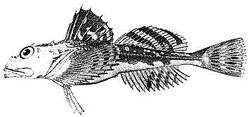Sculpin
Sculpin are a group of fishes that belong to the family Cottidae. They are predominantly found in cold marine waters, although some species inhabit freshwater environments. Sculpins are characterized by their large heads, wide mouths, and spiny fins. Their bodies are typically stout and covered in small scales, or in some species, completely scaleless. These fish vary greatly in size, color, and habitat preferences, making them a diverse group within the aquatic ecosystem.
Description[edit | edit source]
Sculpin fish have a distinctive appearance that sets them apart from other marine and freshwater fish. Their heads are large and bony, with a wide mouth that allows them to consume a variety of prey, including smaller fish, crustaceans, and insects. The pectoral fins of sculpins are broad, aiding in their ability to maneuver in their often rocky or sandy environments. Many sculpins have spines on their heads and fins, which serve as a defense mechanism against predators.
Habitat and Distribution[edit | edit source]
Sculpins are found in a wide range of environments, from shallow, coastal waters to the depths of the ocean. Some species are adapted to life on the ocean floor, where they camouflage themselves among rocks and sand to ambush prey. Freshwater species of sculpin inhabit rivers, streams, and lakes, often preferring cold, clear waters. The distribution of sculpin species is global, with a significant number found in the Arctic, North Atlantic, and Pacific Oceans.
Diet[edit | edit source]
The diet of sculpin fish is varied and largely depends on their size and habitat. Smaller species tend to feed on invertebrates such as crustaceans, insects, and worms, while larger species may prey on smaller fish. Sculpins are generally bottom feeders, using their camouflaged appearance to ambush prey.
Reproduction[edit | edit source]
Sculpin fish exhibit a range of reproductive strategies. Many species lay their eggs in nests, which are often guarded by the male until they hatch. The eggs of sculpin are adhesive and are typically attached to the substrate or hidden within crevices to protect them from predators. The parental care exhibited by sculpin species is notable among fish, with males playing a significant role in ensuring the survival of their offspring.
Conservation[edit | edit source]
While many sculpin species are abundant and not currently at risk, some species have experienced declines due to habitat loss, pollution, and overfishing. Conservation efforts for these species include habitat restoration, pollution control, and the establishment of protected areas. Research into the biology and ecology of sculpin species is essential for developing effective conservation strategies.
In Culture[edit | edit source]
Sculpin fish, though not widely known to the general public, have cultural significance in some regions where they are found. In some areas, they are considered a delicacy and are fished for both commercial and recreational purposes. Additionally, sculpins have been used in scientific research due to their unique physiological traits and adaptability to various environments.
This marine-related article is a stub. You can help WikiMD by expanding it.
Search WikiMD
Ad.Tired of being Overweight? Try W8MD's physician weight loss program.
Semaglutide (Ozempic / Wegovy and Tirzepatide (Mounjaro / Zepbound) available.
Advertise on WikiMD
|
WikiMD's Wellness Encyclopedia |
| Let Food Be Thy Medicine Medicine Thy Food - Hippocrates |
Translate this page: - East Asian
中文,
日本,
한국어,
South Asian
हिन्दी,
தமிழ்,
తెలుగు,
Urdu,
ಕನ್ನಡ,
Southeast Asian
Indonesian,
Vietnamese,
Thai,
မြန်မာဘာသာ,
বাংলা
European
español,
Deutsch,
français,
Greek,
português do Brasil,
polski,
română,
русский,
Nederlands,
norsk,
svenska,
suomi,
Italian
Middle Eastern & African
عربى,
Turkish,
Persian,
Hebrew,
Afrikaans,
isiZulu,
Kiswahili,
Other
Bulgarian,
Hungarian,
Czech,
Swedish,
മലയാളം,
मराठी,
ਪੰਜਾਬੀ,
ગુજરાતી,
Portuguese,
Ukrainian
Medical Disclaimer: WikiMD is not a substitute for professional medical advice. The information on WikiMD is provided as an information resource only, may be incorrect, outdated or misleading, and is not to be used or relied on for any diagnostic or treatment purposes. Please consult your health care provider before making any healthcare decisions or for guidance about a specific medical condition. WikiMD expressly disclaims responsibility, and shall have no liability, for any damages, loss, injury, or liability whatsoever suffered as a result of your reliance on the information contained in this site. By visiting this site you agree to the foregoing terms and conditions, which may from time to time be changed or supplemented by WikiMD. If you do not agree to the foregoing terms and conditions, you should not enter or use this site. See full disclaimer.
Credits:Most images are courtesy of Wikimedia commons, and templates Wikipedia, licensed under CC BY SA or similar.
Contributors: Prab R. Tumpati, MD

